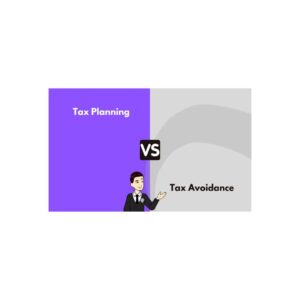
Tax Planning vs. Tax Avoidance: Understanding the Differences
Tax planning and tax avoidance are terms often used interchangeably, but they represent distinct strategies with different legal and ethical implications. Understanding these concepts is crucial for effective financial management and compliance.
Tax Planning
Definition and Purpose Tax planning refers to the strategic approach of organizing financial affairs to minimize tax liabilities within the bounds of the law. It involves making informed decisions about income, investments, and expenditures to maximize tax benefits and ensure efficient tax management.
Key Aspects of Tax Planning:
- Legality: Tax planning is entirely legal and is encouraged as a means to optimize tax liabilities. It involves leveraging provisions within tax laws to achieve a favorable tax position.
- Strategies: Common tax planning strategies include claiming eligible deductions, utilizing tax credits, investing in tax-efficient vehicles like retirement accounts, and timing income and expenditures to benefit from lower tax rates.
- Goals: The primary goal is to legally reduce tax liabilities while ensuring compliance with tax regulations. Effective tax planning can enhance financial stability and increase after-tax income.
Examples of Tax Planning:
- Contributing to a 401(k) or IRA to reduce taxable income.
- Claiming deductions for mortgage interest or charitable donations.
- Investing in municipal bonds that offer tax-exempt interest.
Tax Avoidance
Definition and Purpose Tax avoidance involves structuring financial activities in a way that avoids or reduces tax liabilities, but it operates in a gray area where aggressive strategies may exploit legal loopholes. While technically legal, tax avoidance can be viewed as ethically questionable if it involves exploiting ambiguities in tax laws.
Key Aspects of Tax Avoidance:
- Legality: Tax avoidance is legal but can sometimes border on unethical if it involves manipulating legal loopholes or engaging in complex schemes designed to evade taxes.
- Strategies: Tactics may include shifting income to lower-tax jurisdictions, using complex financial arrangements, or exploiting tax credits and deductions in ways not intended by lawmakers.
- Risks: Aggressive tax avoidance can attract scrutiny from tax authorities and may lead to legal challenges or reputational damage if deemed abusive or contrary to the spirit of the law.
Examples of Tax Avoidance:
- Using offshore accounts or entities to reduce taxable income.
- Structuring transactions in a way that generates artificial deductions or credits.
- Engaging in intricate schemes to shift profits to low-tax jurisdictions.
Key Differences
- Legality vs. Ethical Boundaries: Tax planning stays within the legal framework and follows the intent of tax laws, whereas tax avoidance may exploit legal loopholes and can be seen as pushing the boundaries of acceptable behavior.
- Purpose: Tax planning aims to optimize financial decisions in a lawful manner to reduce tax burdens, while tax avoidance seeks to minimize taxes through potentially questionable methods that exploit legal ambiguities.
- Risk: Effective tax planning carries minimal risk and is generally well-regarded, while aggressive tax avoidance can lead to audits, penalties, and negative public perception.
Conclusion
In summary, tax planning is a prudent and legal approach to managing one’s tax affairs, focusing on maximizing benefits within the legal framework. Tax avoidance, while also legal, involves navigating and sometimes exploiting legal loopholes to reduce tax liabilities, which can carry ethical and reputational risks. Individuals and businesses should strive to engage in responsible tax planning, ensuring compliance with tax laws while avoiding aggressive strategies that may be perceived as avoidance. Understanding the distinction between these approaches can help in making informed financial decisions and maintaining good standing with tax authorities.
For more information visit this site: https://www.incometax.gov.in
FAQ:
1.What is tax planning?
ANS: Tax planning involves arranging your finances in a way that minimizes tax liability within the bounds of the law.
2.What is tax avoidance?
ANS: Tax avoidance refers to strategies used to reduce tax liability through legal methods,
but sometimes exploiting loopholes or ambiguities in the tax laws.
3.Is tax planning legal?
ANS: Yes, tax planning is legal and encouraged to optimize tax efficiency.
4.Is tax avoidance legal?
ANS: Tax avoidance is legal if it adheres to the letter of the law, but it may sometimes be viewed as unethical.
5. How does tax planning differ from tax avoidance?
ANS: Tax planning uses legal methods to minimize tax liability while staying within the law,
whereas tax avoidance often involves taking advantage of legal loopholes or gray areas.
6. Can tax avoidance be challenged?
ANS: Yes, aggressive tax avoidance strategies may be challenged by tax authorities
if they are deemed to contravene the spirit of the law.
7.What are common tax planning strategies?
ANS: Common strategies include utilizing tax deductions, credits, and tax-deferred accounts.
8.What are common tax avoidance techniques?
ANS: Techniques can include setting up complex structures,
shifting income to lower-tax jurisdictions, or exploiting loopholes.
9. How does tax planning impact financial decisions?
ANS: Tax planning helps in making informed decisions that align with financial goals while reducing tax liabilities.
10.How does tax avoidance impact a company or individual?
ANS: While it may reduce tax liabilities, excessive tax avoidance can lead to reputational damage and legal scrutiny.

For further details access our website: https://vibrantfinserv.com
Related Article:
What does tax planning include?
